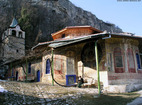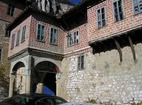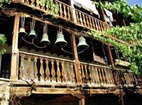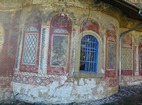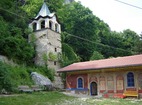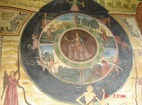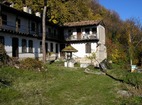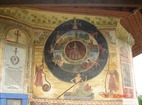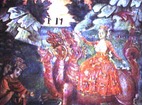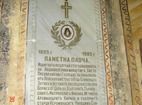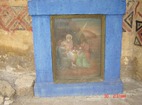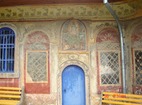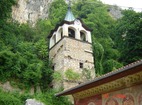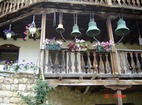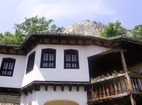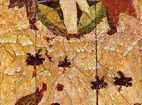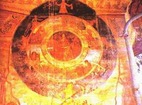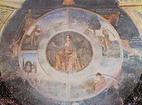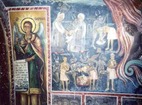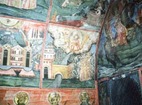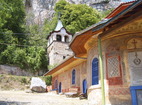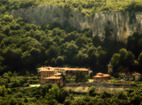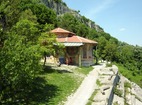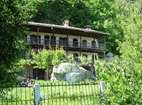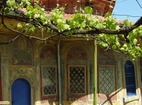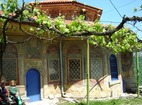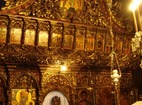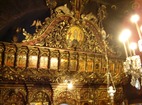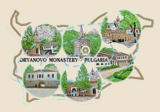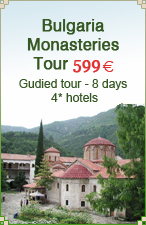Transfiguration monastery "St. Transfiguration"
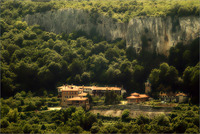
Orthodox name:St. Transfiguration
Near monasteries:Patriarch Monastery
Latest review: I want to fast and pray for about ten days in Bulgaria somewhere. I live in America. Perhaps in the wilderness with the monastary as a base of reference and accountability as far as my where abouts are concerned. Looking for a deeper connection with God.
Patrick Manning, 27.05.2020
See all comments or Post a comment.
Location:
The Transfiguration Monastery lies in a picturesque place on the banks of the Yantra river and 6km north of Veliko Turnovo near the village Samovodene.
Transport:
The offroad to the Transfiguration monastery is about 6km away from the suburbs of Veliko Turnovo off the main road to Rousse.
History:
The Transfiguration Monastery is the biggest monastery of those located in the Veliko Turnovo region and the fourth in Bulgaria. It is a precious architectural and artistic monument in Bulgaria. It was established during the time of the Second Bulgarian Empire in 13-14th century. Originally the monastery was a cloister of the Vatopedi monastery on Mount Athos, but it acquired autonomy in 1360. The emergence of the Transfiguration Monastery is related to the charity of Ivan Alexander's second wife Sarah-Theodora and their son Ivan Shishman since they donated generous funds for its reconstruction and renovation. For that reason the monastery is also called the monastery Sarah's or Shishman's monastery. The shrine played an important role for the spiritual life of the Bulgarian capital city in the 14th century.
In Middle Ages the Transfiguration Monastery was situated about 400-500 m south of its present location. The original place where the monastery stood was abandoned after its destruction during the time when Veliko Turnovo fell under Ottoman yoke in the end of 14th century. After the Ottoman conquest of Bulgaria, the monastery was repeatedly plundered and burned by the Turks and eventually completely destroyed.
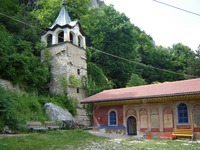 The Transfiguration Monastery was reestablished on its present location by the father Zoticus of the Rila Monastery in 1825. The construction of the main church began in 1834 and was entrusted to Dimitur of Sofia. However, due to his participation of the Velchova Plot in 1834-1835, the master was seized and hanged by the Turks. The noted Bulgarian architect of that time, Kolyo Ficheto, finished the construction of the church. The interior and the outer walls of the temple are decorated with frescoes of high artistic value, created by the eminent Bulgarian icon-painter Zahari Zograf. The whole southeastern wing with the small guest room and the big entrance, the belfry and the small shrine “The Annunciation” were all built until 1863.
The Transfiguration Monastery was reestablished on its present location by the father Zoticus of the Rila Monastery in 1825. The construction of the main church began in 1834 and was entrusted to Dimitur of Sofia. However, due to his participation of the Velchova Plot in 1834-1835, the master was seized and hanged by the Turks. The noted Bulgarian architect of that time, Kolyo Ficheto, finished the construction of the church. The interior and the outer walls of the temple are decorated with frescoes of high artistic value, created by the eminent Bulgarian icon-painter Zahari Zograf. The whole southeastern wing with the small guest room and the big entrance, the belfry and the small shrine “The Annunciation” were all built until 1863.
The Transfiguration Monastery was reestablished on its present location by the father Zoticus of the Rila Monastery in 1825. The construction of the main church began in 1834 and was entrusted to Dimitur of Sofia. However, due to his participation of the Velchova Plot in 1834-1835, the master was seized and hanged by the Turks. The noted Bulgarian architect of that time, Kolyo Ficheto, finished the construction of the church. The interior and the outer walls of the temple are decorated with frescoes of high artistic value, created by the eminent Bulgarian icon-painter Zahari Zograf. The whole southeastern wing with the small guest room and the big entrance, the belfry and the small shrine “The Annunciation” were all built until 1863.
During the time of the father Zoicus, the Transfiguration Monastery has gradually turned into one of the main cultural and revolutionary centres in the Veliko Turnovo region. The Apostle of Freedom, Vassil Levski, found his shelter several times in the monastery. The Transfiguration cloister played an important role in the struggles of Bulgarian nation for religious and national independence. Similarly to other monasteries dated back to that time, the monastery was turned into a hospital during the time of the Russian-Turkish Liberation war. As a gesture of gratitude, after the Liberation Russian soldiers made gifts to the monastery, the bells, chandeliers and liturgy books for the church.
Some of the monks’ cells in the Transfiguration Monastery were destroyed in 1991 after the demolition of the rocks above the monastery.
Architecture and present condition:
At present the nunnery is operational.
The present appearance of the monastery was acquired from 1858 to 1863 and it is typical for the medieval monasteries-fortresses. The buildings are arranged and they form an oblong courtyard as the lower floors are made of stone and the upper are connected in harmony with the inclination of the land. The main buildings were constructed in the first half of the 19th century by the notable Bulgarian architect Kolyo Ficheto. At that time the main church, the whole southeastern wing with the small guest room and the big entrance gate, the belfry and the small church “The Annunciation” were built. The churchyard “Resurrection of Lazar” was finished in 1891 and the buildings of the kitchen room, dining hall and the library were erected in 1894.
The Transfiguration Monastery was reestablished on its present location by the father Zoticus of the Rila Monastery in 1825. The construction of the main church began in 1834 and was entrusted to Dimitur of Sofia. However, due to his participation of the Velchova Plot in 1834-1835, the master was seized and hanged by the Turks. The noted Bulgarian architect of that time, Kolyo Ficheto, finished the construction of the church. The monastery temple is one-apse, one-domed building with three columns which features the style characteristics of the Athos monastery temples. The church has a unique design which is incomparable to any other shrine in a Bulgarian monastery.
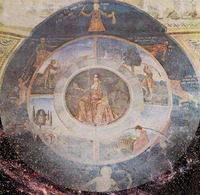 The unique frescoes in the church were created by the renowned icon-painter, Zahari Zograf, a representative of the popular Samokov painting school. Zahari worked on the masterpieces of high artistic value of Bulgarian Renaissance art from 1849 to 1851. He painted the figures of the Slav enlighteners Cyril and Methodius, as well as a self-portrait. The stunning big scene “Day of Judgement” on the east wall in the narthex is of great interest for visitors. The remarkable scene “The cycle of Life”, painted on the outer altar wall is also noteworthy.
The unique frescoes in the church were created by the renowned icon-painter, Zahari Zograf, a representative of the popular Samokov painting school. Zahari worked on the masterpieces of high artistic value of Bulgarian Renaissance art from 1849 to 1851. He painted the figures of the Slav enlighteners Cyril and Methodius, as well as a self-portrait. The stunning big scene “Day of Judgement” on the east wall in the narthex is of great interest for visitors. The remarkable scene “The cycle of Life”, painted on the outer altar wall is also noteworthy.
The iconostasis of the church was created in 1838 by a group of masters-wood carvers from the Tryavna Wood-carving school. Icons on it are masterpieces of Zahari Zograf and his nephew Stanislav Dospevski. Some of the most remarkable icons are “Archangel Michael”, “Joan Precursor”, “St. Andrey” and etc.
The Transfiguration Monastery has a library and a museum exposition which house historical documents, deeds, valuable medieval Bulgarian books and icons and other high-value artistic items.
Telephone number of the monastery:+ 359/International dialling code for Bulgaria/ 62 23076
Accommodation:
The Transfiguration Monastery does not offer food and accommodation. However, visitors can go to Veliko Turnovo town where a wide choice of hotels and restaurants can be found.
Places of interest in the region:
Tourist national places in close proximity to the Transfiguration Monastery: Architectural and historical reserve Tsarevets (5,5 km), Architectural and museum resort Arbanassi (6km).
Photogallery:
Patrick Manning for Transfiguration monastery , 27.05.2020
I want to fast and pray for about ten days in Bulgaria somewhere. I live in America. Perhaps in the wilderness with the monastary as a base of reference and accountability as far as my where abouts are concerned. Looking for a deeper connection with God.
freetarotpsychicreadings for Transfiguration monastery , 24.02.2016
I just found this blog and have high hopes for it to continue. Keep up the great work, its hard to find good ones. I have added to my favorites. Thank You.


